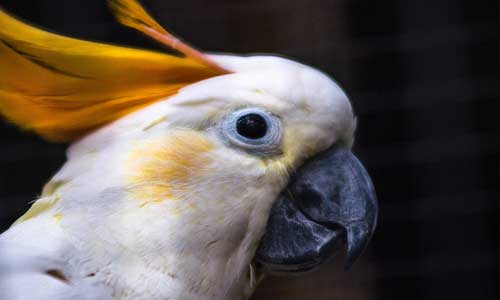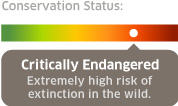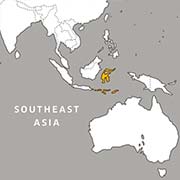Citron-Crested Cockatoo
Cacatua sulphurea
You Can Find This Animal in the Outback Trail
Strike a pose
Citron-crested cockatoos sometimes raise their colorful crest feathers when surprised or excited.


Geographic Range:

Class: Aves
Order: Psittaciformes
Family: Cacatuidae
Genus: Cacatua
Species: sulphurea
Subspecies: C. s. citrinocristata
Citron-crested cockatoos are named for the crest of brightly colored feathers on the tops of their heads. The cutting down of forests in Indonesia paired with the cockatoos being illegally caught to be sold as pets has caused this species to become critically endangered. Like other species of parrots, cockatoos can live a long time. In the wild they live to around age 40, but in captivity they can live for 70 or more years.
Appearance:
The citron-crested cockatoo is a medium-sized cockatoo with a white body, gray beak, and orange/yellow colored feathers on the top of its head (its “crest”). The underside of its wings and tail feathers are pale yellow. Both males and females look similar. The citron-crested cockatoo looks very similar to the sulphur-crested cockatoo, a larger species sometimes bred to be sold as a pet.
Size:
13 inches tall
Diet:
Consists mainly of buds, fruits, nuts, seeds and some herbaceous plants.
Incubation:
Female will lay between two to three eggs. Both parents will take turns incubating the egg, which can take up to 30 days to hatch. The young are naked and blind when hatched, and may take several weeks to open their eyes. Hatchlings may take between 60 and 100 days to become fully plumed. Afterward they will begin to explore outside of the nest.
Behavior:
Citron-crested cockatoos sometimes raise their colorful crest feathers when surprised or excited. Though they're quieter than some other species of cockatoos, they sometimes shriek loudly and have the ability to imitate the calls of other birds and animals. Some citron-crested cockatoos can even “speak” by imitating humans.
Habitat/Range:
Most citron-crested cockatoos are only found on the island of Sumba in Indonesia. There may be some on small neighboring islands, such as Komodo. They live in trees in moist deciduous forests, semi-evergreen forests, and scrubland.
Median Life Expectancy:
30 years
Threats in the Wild:
Citron-crested cockatoos are critically endangered. The population has sharply declined in the last 20 years. The decline is mostly due to illegal trapping for the pet trade. Logging and the conversion of forest to farm land also threatens citron-crested cockatoo populations.
Citron-crested cockatoos sometimes raise their colorful crest feathers when surprised or excited.
At Franklin Park Zoo:
At Stone Zoo:

